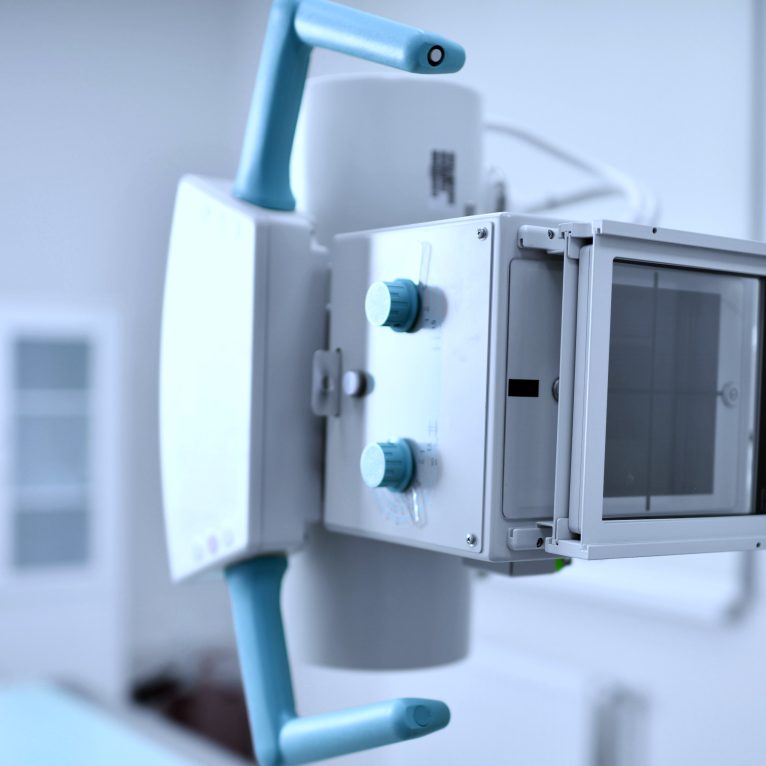
Written by

ECR returned to its first in person conference since February 2019, with the usual timing of the tradeshow shifting from early March to mid-July. Overall, exhibitors were disappointed with the underwhelming level of footfall of attendees, in particular radiologists. Over 10,000 professional attendees were present, alongside 5,000 industry representatives. Both online and in person attendance totalled 15,700.
The timing for ECR 2022, clashing with Northern and Western Europe summer vacations, as well as the conflict with France’s Bastille Day, is most certainly a contributing factor. A further combination of travel disruptions globally, continued concerns of COVID-19 and increased online access of the tradeshow further exacerbated the reduction in attendance. The unconventional layout of the ECR 2022 floor plan also resulted some dismay amongst both attendees and exhibitors, with restricted ease of access and visibility to some booths, as well as exhibitory displays outside of the main exhibition floors being very enclosed and elusive. Below, we assess how we performed against our predictions for ECR 2022.
Medical Imaging
Tailored solutions for out of hospital imaging: Our prediction: Solutions for out of hospital imaging have in the past been a primary focus for more novel vendors. However, the established imaging vendors will increasingly demonstrate how adaptable their solutions are to such outpatient settings, and how they can be a valuable partner and offer bespoke expertise in this transition which continues to drive expansion of healthcare networks.
Our conclusions: In developed markets, most of the growth within inpatient facilities is accounted for by the replacement market. As a result, imaging vendors are increasing adapting their offerings to outpatient settings and mobile facilities. As more procedures are being shifted to out of hospital care settings and officed based labs and ambulatory surgery care centres, leading endorse such as Philips are widely promoting their expertise in out of hospital solutions, including the Symphony Suite. Canon Medical also displayed its mobile CT solution, the City Hopper, at the entrance of the ECR conference.
Continued focus on advanced imaging systems: Our prediction: advanced imaging modalities such as image guided therapy solutions, MRI and CT will be at the forefront of the latest innovation and product developments presented by medical imaging vendors. Reduced scan or procedure times and optimized operational efficiency are amongst some of the latest features to be demonstrated.
Our conclusions: Amongst the market leaders in medical imaging, most product launches and latest innovations highlighted were centred around their advanced imaging systems portfolio. ‘Hero products’ included multi-nuclear MRI, spectral CT, Angio-CT and photon counting CT. Such state-of-the-art technology has limited appeal outside of academic centres currently and also has limited interest for most providers struggling with over-subscribed imaging services. Broader developments amongst the workhorse solutions in the MRI and CT market went some way to support this challenge, including enhanced patient experience, a reduction in scan time, AI image reconstruction and improvements in speed of image acquisition. Use of AI-powered algorithms in both MRI and CT are being used to eliminate the need to compromise between scan time, resolution and signal-to-noise ratio. With both MRI and CT considered to be growth markets over the upcoming years, it is not surprising that imaging vendors are extending their offerings and capabilities in these markets.
Implementation of imaging software outside of diagnostic imaging: Our prediction: primary use and implementation of AI typically been for diagnostic imaging solutions. Image guided therapy vendors will exhibit developments such as live fusion imaging capabilities. Industry firsts will include incorporation of AI into the image processing engine of angiography systems to improve visibility of medical devices and reductions in dose administration, as well as 3D visualization software with AI-based procedural guidance for niche interventional procedures.
Our conclusions: Over recent years, implementation of AI in medical imaging has had primary focus in diagnostic imaging. However, at ECR 2022 there were increasing demonstrations of AI’s expansion into image guided therapy. Virtual attendance by multiple Japanese vendors meant some new products, such as AI-enhanced image processing on angiography systems, were only launched virtually. However, Philips highlighted several examples of AI use, in its end-to-end AI based stroke triage and management using its StrokeViewer in collaboration with Nico lab, and the second being it’s EPIQ CVXi interventional cardiology ultrasound system enabling greater control of live fusion-imaging on the Philips Azurion platform and extended anatomical intelligence models.
Precision medicine and clinical pathways: Our prediction: precision medicine continues to be a prominent theme in medical imaging and at ECR 2022 we expect to see demonstrations of end-to-end comprehensive solutions enabling imaging diagnosis, guidance, AI-based triage, treatment, and management of bespoke clinical care pathways. Optimized clinical pathways and simplified workflows will be prominent themes.
Our conclusions: A shift in how vendors are showcasing their leading product lines was evident at ECR 2022. Vendors are increasingly presenting end-to-end solutions for dedicated care pathways, such as trauma solutions for emergency rooms or comprehensive stroke care pathways. Demonstration of such holistic solutions included comprehensive range of diagnostic imaging, image guided therapy, monitoring and assessment and AI for triage and management. Purchasing preferences of healthcare providers are shifting from traditional transactional sales to complete solutions for dedicated care pathways, often as part of managed equipment service deals.
Ergonomics, ease of use and workflow efficiencies: Our prediction: from a hardware perspective, vendors will continue to evolve their ergonomic designs to improve the end-user experience, enhanced operational efficiency through simplified workflows and more streamlined designs to reduce the chronic strain placed on technicians.
Our conclusions:Examples of streamlined and smarter workflows were widely demonstrated by imaging vendors, with key highlights including embedded camera-based workflows, multiple control interfaces including tablet-based consoles, smart protocolling, one-click examinations and AI driven quality checks providing immediate feedback at the point of image acquisition to improve examination accuracy. These notable enhancements are tailored towards the need for increased patient throughput to meet the pressure on imaging services. Such developments are predominantly a continuation of what vendors previously showcased at RSNA 2021 and will remain a key theme for the near-term.
Sustainable solutions for long term use and smart subscriptions: Our prediction: imaging vendors are increasingly offering more sustainable products designed for long term use by providing subscription services which enable ongoing access to software updates and upgrades to the latest features.
Our conclusions: Increased promotion and talk of smart subscriptions, to ensure imaging systems can be utilised for the maximum installation period was, as predicted, evident at ECR 2022. Leading imaging vendors presented their sustainable solutions to ensure the capabilities of the system are continually updated when software upgrades are available. This is a key factor in the current healthcare climate, where budgets are under constraint, yet access to the latest innovation in technology is desirable. The importance of sustainable solutions was spearheaded by GE Healthcare in particular, with sustainability and resilience part of its three pillars‚ marketing its broad imaging portfolio. Philips also hosted dedicated interactive sessions on sustainable and resilient radiology solutions within its offering.
Healthcare IT
Our prediction: Cloud: despite slower transition to public cloud in Europe, vendors will continue to release new or re-architected “cloud native” product modules for private and hybrid cloud deployment. Operational workflow tools, clinical viewers, business intelligence and data management platforms for imaging IT will be the highlights of releases.
Our conclusions: Cloud was, as predicted, a prominent theme at ECR 2022, though more muted compared to RSNA late last year. Given the relative complexity of local regulations around patient data and consequent in Europe, momentum for cloud adoption has been slower to build. Healthcare providers in some markets (UK for example) are more aggressively pursuing public cloud deployments with leading global hyperscalers (Amazon, Google, Microsoft etc.), though in other regions many providers are looking to hybrid or private cloud as a longer-term strategy for imaging informatics. Therefore, vendors at the show were endeavouring to show their flexibility in terms of deployment – to mixed success – with clinical viewers and workflow solutions for imaging widely available. However, many vendors are still are undergoing re-architecting across diverse, multi-ology portfolios to leverage cloud technology, with limited progress made on diagnostic viewers, advanced visualisation and data management products. Combined with local regulatory hurdles, the broader European market looks set to be a cloud ‚laggard in comparison to North America for the mid-term at least.
Enterprise Imaging, Multi-ology: Our prediction: while most of Europe has been focusing on consolidating radiology IT (enterprise radiology) growing availability of typically siloed departments diagnostic offerings will be consolidated into single platforms. Consolidation of breast imaging, non-invasive cardiology, emergency medicine, POCUS, ophthalmology, and visible light imaging (dermatology etc.) will be more prominent. Discussion and partnerships for Digital Pathology consolidation with Radiology will also intensify.
Our conclusions: Enterprise imaging strategies continue to be prominent across the Western European market, with the increased release of multi-ology tenders, for example radiology and cardiology, as well as the addition of digital pathology in select European market. Despite the market direction, there were limited new announcements, and the overall conversation on digital pathology was minimal at ECR, a surprising trend compared to the prominence it has taken at American conferences such as RSNA and SIIM. We anticipate this to be short-lived however, given recent evidence from our research suggesting healthcare providers are increasingly including multi-ology capability into new tenders and procurement frameworks. Further, Europe has one of the most mature digital pathology markets globally, with growing support at healthcare providers for improved exchange between pathology and radiology as part of integrated care pathways.
Business model evolution: Our prediction: as healthcare providers seek to de-risk investment, managed service and operational business models will be more prominently showcased for imaging IT products. Vendor flexibility will be crucial providing customers an opportunity to mix and match purchasing models across procurement.
Our conclusions: Post-pandemic, we witnessed many imaging IT vendors release subscription models, as the market pivots away from capital expenditure budgets due to financial pressures, a trend led by the US market. However, at ECR, announcements on business model evolution were sparse. The dominance of public healthcare systems across Western Europe, with provider financial structure and government budget allocation lending itself to capital purchasing, is a key influence. The market still requires flexibility however; in Western Europe, this aligns to the opportunity of managed services, with a great drive towards outsourcing to imaging IT vendors, as opposed to pure-play SaaS models for example. Further, combining modality and imaging IT portfolios into ‘service-line’ agreements in radiology will become more prominent, ensuring longer-term cost-efficiency benefits for providers, even in markets with more traditional capital-intensive budget cycles.
New AI Solutions: Our prediction: New and existing clinical AI vendors will showcase products targeting less common clinical segments and/or use cases, e.g., aneurysms, prostate, MSK MRI. Imaging IT vendors will continue to roll out orchestration platforms and broader integration roadmaps.
Our conclusions: There was increasing evidence at ECR 2022 of vendors looking beyond the more established clinical segments for medical imaging AI. For example, at the show Koios has expanded its ultrasound AI capabilities, to a full toolset for the relatively niche segment, thyroid ultrasound. Quibim, which has committed to becoming an imaging biomarker company targeting pharma, has also re-aligned its radiology AI business around a new use case for its prostate AI solution.
Smart Soft Healthcare, a new vendor at ECR, showcased CoLumbo, an AI tool for analysing the lumbar spine, which has successfully received both CE Mark and US-FDA clearance. It is one of the first AI solutions to receive regulatory clearance for spine MRI. ScanDiags (formerly Balzano), which was also exhibiting at ECR and established before Smart Soft, has still yet to receive regulatory clearance for its spine MR AI solution, highlighting the complexities of entering less mature clinical segments.
Imaging IT vendors focused their efforts on addressing the ‘last mile’ challenges of adopting AI: deployment and integration, yet progress has been relatively slow. Beyond the imaging IT vendors, several vendors with third-party AI platforms (e.g., deepC, Aidoc) also exhibited at ECR. Bayer, an established entity in the pharmaceutical and radiology contrast media markets, entered the radiology AI market with its Calantic platform. The company highlighted the AI platform’s capabilities to offer value across a service line (e.g., neurology imaging) and offer value downstream of image analysis (i.e., its automated reporting capabilities).
Greater emphasis on workflow: Our prediction: AI solutions from vendors will tout greater workflow capabilities beyond image analysis, with the aim of delivering greater value to the radiologist. These solutions will be targeted at emergency and critical care conditions, e.g., pulmonary embolism, aortic dissection, stroke imaging.
Our conclusions: More established AI independent software vendors (ISVs) (e.g., Aidoc, Blackford Analysis) have started to expand their focus beyond image analysis capabilities and develop ‘end-to-end’ solutions for critical care cases, such as care coordination solutions for stroke imaging and pulmonary embolism. Focusing on workflow solutions that deliver greater value to the wider patient care team and “downstream” of imaging, rather than just radiologists reading, enables vendors to highlight the value for their customers.
There was limited focus on such capabilities at ECR, as many of the vendors exhibiting were still grappling with how to get the attention of potential prospects and tout the capabilities of their specific AI tools, as opposed to expanding their focus beyond radiology. To deliver value to customers, AI, ISVs should address the question of ‚what problem needs to be solved, rather than developing AI with marginal impacts on care outcomes.
Nevertheless, the conversation, clear at ECR from attendees, was what AI do I need?, rather than ‘do I need AI?’ as it was at the last in-person event, indicative of how the medical imaging AI market in Western Europe is evolving and gradually gaining more traction.
Product Evolution: Our prediction: Narrow point algorithms for singe tasks will be less sought after and vendors will highlight enhanced capabilities of their products and how they help clinicians address specific problems.
Narrow point algorithms for single tasks will only deliver value for highly specialised tasks, such as FFR-CT analysis. Vendors are therefore exploring how they can add value to their AI algorithms and create solutions that address ‘bottlenecks’ or problems for radiologists. One approach is focusing on the workflow (as described above). Another is developing comprehensive AI solutions that can detect, triage, and/or quantify multiple findings or pathologies from a single scan, removing the need for discrete algorithms for each finding.
Some of the most successful vendors targeting the comprehensive approach have been Annalise.ai, Qure.ai, and Oxipit (all exhibited at ECR) for ‘chest x-ray’ solutions. However, more vendors are targeting this approach in other applications. For example, Siemens Healthineers’ AI-Rad Companion Chest CT solution and contextflow with its SEARCH Lung CT solution are both comprehensive chest CT solutions. Beyond that, Brainscan.ai was one of the few AI vendors to showcase its head CT solution, which identifies multiple pathologies from a single head CT scan.
Other vendors will follow, and it is evident that the market is moving in this direction as vendors strive to offer value and justify commercial deployment. Further, AI platform vendors are also looking to combining the capabilities of individual vendors into a single packaged solution. Acquisitions of smaller vendors are also likely near-term, further consolidating the market. However, there was little evidence of such activity at ECR, but this should not be ruled out in the short term as funding runways run-out with growing economic pressure.
About Signify Research
Signify Research is an independent supplier of market intelligence and consultancy to the global healthcare technology industry. Our major coverage areas are Healthcare IT, Medical Imaging and Digital Health. Our clients include technology vendors, healthcare providers and payers, management consultants and investors. Signify Research is headquartered in Cranfield, UK. To find out more: enquiries@signifyresearch.net, T: +44 (0) 1234 436 150, www.signifyresearch.net

